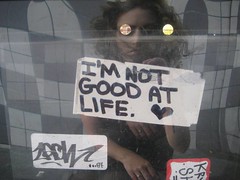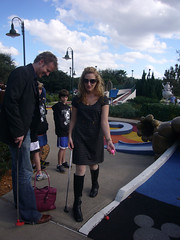Below is the introduction to my Game Designer’s Rant, which I delivered at the Game Developers Conference today. It was really well-received, which I'm happy about. ^_^
The GDC Rant, where typically high-profile game designers and developers get to yell and scream about whatever they want, is pretty much my favorite panel of GDC every year. So being invited to be on the rant – along with Clint Hocking, Chris Hecker, Daniel James, Jenova Chen, and Jon Mak -- was such a delight, and a big honor. I was so happy giving this talk. Between this intro, the conclusion, and the slides, you’ll get a good idea of what I was ranting about.
You can download the slides here: Jane McGonigal's 2008 GDC Rant: "Reality is Broken"
[INTRO] I’m not here to rant about game designers. I’m mad, but I’m not mad at game designers. I think that compared to the rest of the world, game designers pretty much have it all figured out. We’ve invented a medium that kicks every other medium’s ass. As game designers, we own more emotional bandwidth, we occupy more brain cycles, and we make more people happy than any other platform or content in the world. And if you don’t already believe that, if you don’t realize that we’ve already won, then you’re not paying attention to the staggering amount of time, energy, money and passion that gamers all over the world pour into our games every single day.
So why why have we won? Because as an industry, we’ve spent the last 30 years learning how to optimize human experience. We know that our brains are made for playing games. Recently, some of us have remembered that our bodies are made for playing games. And we’ve always known that our hearts are made for playing games. So as an industry, we’ve spent three whole decades figuring out how to engineer systems that fully engage our brains, and our bodies, and our hearts. And we’ve pretty much solved that problem – or, at least, our solutions are working better than other designed experience on the planet. So our systems work better than anything anyone else is making to engage human beings. And as a result, the way I see it, right now, we basically rule the world.
That’s the good news. But the problem is, we don’t rule the real world. For the most part, we rule the virtual world, because it’s easier to optimize experience in a world entirely of our own making. The fact is the real world is too f’ed up, it’s too broken, we don’t want to deal with it. So right now, pretty much every one of our games works better than reality, because we are the best designers of human experience, and we’re applying all of our talent, all our insight to optimizing virtual experience. And you know what? That needs to end, starting today.
[START SLIDES] My rant is about the fact that reality is fundamentally broken, and we have a responsibility as game designers to fix it, with better algorithms and better missions and better feedback and better stories and better community and everything else we know how to make. We have a responsibility as the smartest people in the world, the people who understand how to make systems that make people feel engaged, successful, happy, and completely alive, and we have the knowledge and the power to invent systems that make reality work better. We have the responsibility to take what we’ve learned as an industry over the past 30 years and start making everyday life more like our games. [
[START IMPROVISING!]
[CONCLUSION]
Can we fix it? Yes. We have the technology and the knowledge. Should we fix it? Hell yes. We have the power AND the responsibility. That doesn’t mean we should stop making escapist games. We need to make escapist games, there will always be a need to escape, and frankly, that’s how we’re going to learn more about what works, about how to engage brains and bodies and hearts. But will we fix it? Honestly, I have no idea. I have no idea how many of you are sitting there thinking I’m completely nuts, or worse, that I just don’t get it, that games are for having fun, that they don’t have to be real, they don’t have to fix anything. They’re games, isn’t that enough?
Well, I don’t think that it’s enough. We make the games, we have the knowledge, and we have the power. We can take what we’ve learned by making games and apply it to reality, to make real life work more like a game – not make our games more realistic and lifelike, but make our real life more game like – so that when people all over the world wake up every morning, they wake up with a mission, with allies, with a sense of being a part of a bigger story, part of a system that wants them to be happy. We can do it, we should do it, and I hope that we will do it.



